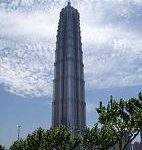China’s large-scale urbanisation dates back to late 1980s, when Beijing still had fields and natural wetlands. Since the 1980s, urbanisation has accelerated, with the number of cities in China’s central and coastal regions leaping from 315 to 521 from 1988 to 2000. Cities are expanding at an even faster rate than their populations. Urban land increased by 8% from 2000 to 2003, while the urban population grew by only half that figure. And now the country has become a giant building site, with almost 770 square kilometers of land being built on annually — a figure that increases by almost 6% annually.
This urban explosion is linked to an unfortunate quest for large, foreign-style cities. Cities, plazas, roads, houses – the bigger and more foreign they are, the better, whether they are needed or not. Cities are swallowing up their surroundings – particularly Beijing, which is expanding by 20 square kilometers per year and showing no sign of slowing. Economically backward cities build huge plazas, cities with no congestion build eight-lane highways, all for the sake of appearance. The trend for spacious accommodation started with Beijing officials, with the standard living area for a departmental cadre rocketing from 70 or 80 square meters to over 200. There is even competition over who has the biggest office. And buildings are built in foreign styles, leaving us with non-descript cookie-cutter cities.
This construction makes an undeniable contribution to GDP, but the ecological and social issues it causes have been ignored. The current urbanisation rate is about 40%. If China is to achieve moderate levels of development, this will rise to 60% – encroaching on even more land and using even more resources. If China’s urbanisation is to be sustainable, the country must halt excessive expansion and resolve the issues discussed below.
Big cities or small towns?
China’s urbanization is focused on expanding its cities – there are lots of people, so you enlarge the city – and that expansion then attracts more people. This unlimited expansion causes more pollution, congestion and poor living conditions, threatening the natural and rural environment.
Urbanisation in China is different to that of developed countries. The nature of the population flow is different. When rapid urbanisation started in 1960s America, the country had a population of only 23 million. But China’s urbanisation has been a quick expansion of residential areas and transport infrastructure to envelop populations. In the next 25 years, 850 million rural residents will be relocated to the cities. The use of resources is also different. Materials for the United Kingdom’s urbanisation were supplied by its colonies worldwide, but China must rely on its own (non-renewable) sand, soil, stone and steel.
And so this rapid expansion is not feasible for China. We need smaller cities with a range of employers to attract rural labour. Green belts similar to those surrounding England’s cities should be used to protect the environment and limit urban expansion.
Solid, practical cities – not showpieces
The desire for the foreign is widespread. Traditional Chinese architecture is frowned upon, with US and European styles preferred. (Even the statues are bare-arsed Greeks.) Municipal leaders think it reflects better on them, and the city planners know where the money comes from. And in this rush for Roman plazas and European streets, China’s own traditional culture is lost and our cities all come to look the same.
Dreams of western lifestyles see the rich spending their money on large apartments or villas, which are eating up China’s parks and scenic areas. The well-known Fragrant Hills in Beijing are now surrounded by housing. Despite astronomical prices, supply can’t keep up with demand. Many are purchased merely as status symbols by people too busy to live there; they sit empty, as in a ghost town.
These problems permeate China’s urbanisation and are causing excessive expansion and massive waste of land and resources. Green areas and natural habitats are shrinking and the cities are losing their individuality. Urbanisation requires practical infrastructure and smaller housing. The government has recently taken steps in this direction, but their effect remains to be seen.
How long will non-renewable resources last?
One direct result of urban expansion is the massive consumption of non-renewable resources. Villages surrounding cities are being replaced with high-rises. This “fast-food” approach to urbanisation is destroying villages and consuming precious non-renewable materials.
Management of China’s waterways is chaotic, with contractors able to dredge sand at little or no cost. An excavator hired at CHY 200 an hour [$25] can scoop up a tonne of sand in no time – sand which then no longer helps to control floods and to filter water. Many natural waterways are disappearing, along with the wetland vegetation on their banks.
Rock and soil face a similar fate. Entire mountains are carved up for sale. Boulders weighing a tonne are sold off by the roadside. Granite and marble are processed into artworks to be sold abroad, and clay is fired into bricks for buildings.
And yet the buildings China is throwing up today are of poor quality, built with demolition and rebuilding in mind, further depleting building materials. If this continues, our supply of sand, then clay and finally stone, will be depleted.
This is our last chance to preserve these materials. We need quality buildings made to last. We need to consider the use of renewable or reclaimed building materials – for example, banning the use of clay bricks in favour of those manufactured from coal ash. Only in this way can we leave some of these non-renewable materials for future generations.
Homepage photo by Vagrantant
The author: Jiang Gaoming is a professor at the Chinese Academy of Sciences’ Institute of Botany and a doctoral candidate tutor, vice secretary-general of the United Nations Educational, Cultural and Scientific Organisation’s China-MAB (Man and the Biosphere) Committee and member of the UNESCO MAB Urban Group. He is recognised for his introduction of the concepts of urban vegetation and using natural forces to restore China’s ecosystems.


